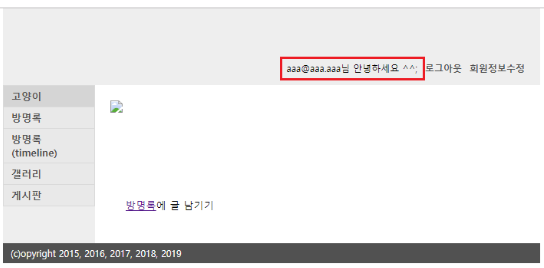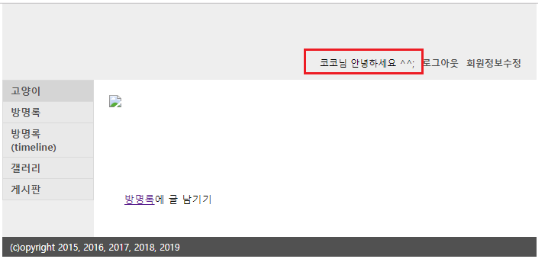3 Spring Security - Authorization(권한) 설정(ROLE), TagLib authorize 추가
18 Jul 2019 | Java Spring SpringSecurity Authorization[ 목차 ]
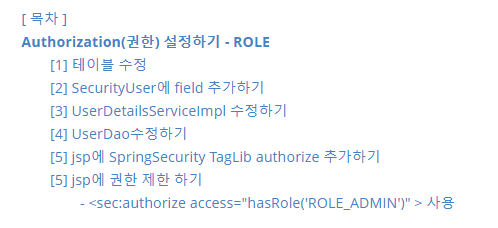
project 전체 코드 보기
Authorization(권한) 설정하기 - ROLE
[1] 테이블 수정
ROLE을 아래의 형태로 받을 예정이다.
- 회원 권한 :
ROLE_USER - 관리자 권한 :
ROLE_ADMIN
위의 형태로 받기 위해서 table의 role컬럼(기존 enum(‘USER’, ‘ADMIN’) 형태)과 데이터를 수정했다.
alter table user
change column role
role enum('ROLE_USER','ROLE_ADMIN');
update user set role="ROLE_USER";
update user set role="ROLE_ADMIN" where name = "관리자";
수정 후 데이터

[2] SecurityUser에 field 추가하기
SecurityUser는 회원 정보를 저장하는 역할이다. (UserDetails를 구현한 클래스)
SecurityUser.java의 기존 field
private String name; // biz data
private Collection<? extends GrantedAuthority> authorities;
private String username;
private String password;
no filed 추가 후 getter, setter 추가
// domain fields(principal: 보호할 사용자 중요 데이터)
private Long no;
private String name; // biz data
// security fields
private Collection<? extends GrantedAuthority> authorities;
private String username; // credential(email)
private String password; // credential
...
public Long getNo() {
return no;
}
public void setNo(Long no) {
this.no = no;
}
...
인증을 위한 security fields와, 회원의 중요 데이터 domain fields 가 있다.
다른 회원 정보를 추가하기 위해서 domain fields 쪽에 필드를 추가해주면 된다.
[3] UserDetailsServiceImpl 수정하기
이전 코드
@Component
public class UserDetailsServiceImpl implements UserDetailsService {
@Autowired
private UserDao userDao;
@Override
public UserDetails loadUserByUsername(String username) throws UsernameNotFoundException {
UserVo userVo = userDao.get(username);
SecurityUser securityUser = new SecurityUser();
if ( userVo != null ) {
securityUser.setName(userVo.getName());
securityUser.setUsername(userVo.getEmail()); // credential
securityUser.setPassword(userVo.getPassword()); // credetial
List<GrantedAuthority> authorities = new ArrayList<GrantedAuthority>();
authorities.add(new SimpleGrantedAuthority(userVo.getRole()));
}
return securityUser;
}
}
이전 코드에서는 securityUser의 no field가 없어 no를 넣어주지 못했다.
no추가와 권한추가 코드(authorities)를 수정했다.
수정 후 코드
@Component
public class UserDetailsServiceImpl implements UserDetailsService {
@Autowired
private UserDao userDao;
@Override
public UserDetails loadUserByUsername(String username) throws UsernameNotFoundException {
UserVo userVo = userDao.get(username);
SecurityUser securityUser = new SecurityUser();
if ( userVo != null ) {
securityUser.setNo(userVo.getNo()); // setNo코드 추가
securityUser.setName(userVo.getName());
securityUser.setUsername(userVo.getEmail()); // credential
securityUser.setPassword(userVo.getPassword()); // credetial
securityUser.setAuthorities(Arrays.asList(new SimpleGrantedAuthority(userVo.getRole()))); // 한줄로 요약
}
return securityUser;
}
}
[4] UserDao수정하기
이전코드
UserDao.java 에서 임시 데이터를 return 했다.
public UserVo get(String email) {
UserVo vo = new UserVo();
vo.setName("이정은");
vo.setNo(1L);
vo.setEmail("aaa");
vo.setPassword("1234");
vo.setRole("ROLE_USER");
return vo;
}
수정 후 코드 : mybatis를 통해 db에서 실제 데이터를 가져옴
username대신 email이 credential이다.
public UserVo get(String email) {
return sqlSession.selectOne("user.getByEmail", email);
}
여기 까지 수정했다면 이제 SercurityUser 객체(?)는 ROLE 권한(setAuthorities)을 갖게된다.
일반 회원일 경우 ROLE_USER, 관리자일 경우 ROLE_ADMIN이다.
해당 권한은 WebSecurityConfigurerAdapter를 구현한 SecurityConfig.java클래스에서 사용할 수 있다.
지난 포스팅에서
아래의 그림과 같이,

antMatchers를 통해 /admin/** 경로는 ROLE_ADMIN 권한을 갖게 했었다.
이제 DB를 통해서 정말로 사용자 데이터의 ROLE을 가져오기 때문에,
권한을 통해 오직 관리자(ROLE_ADMIN 권한을 가진 회원)만 /admin/** 경로에 접근 할 수 있게 되었다.
(이 설정을 하기 전에는 모~든 회원이 Forbidden 403페이지가 떴었다.)
[5] jsp에 SpringSecurity TagLib authorize 추가하기
태그 라이브러리 사용을 위해 pom.xml에 라이브러리가 추가 되어있어야한다.
<dependency>
<groupId>org.springframework.security</groupId>
<artifactId>spring-security-taglibs</artifactId>
<version>${org.springsecurity-version}</version>
</dependency>
로그인 회원, 비 로그인 회원 분리
<sec:authorize access="isAuthenticated()">를 통해 인증된(로그인한) 회원이라면 회원정보 수정과 로그아웃을 보여준다. 비 로그인 회원일 경우 로그인과 회원가입 버튼을 보여준다.
taglib추가 후 코드 수정하기
<%@ taglib prefix="sec" uri="http://www.springframework.org/security/tags" %>
<sec:authorize access="isAuthenticated()">
<li><a href="${pageContext.servletContext.contextPath}/user/update">회원정보수정</a></li>
<li><a href="${pageContext.servletContext.contextPath}/user/logout">로그아웃</a></li>
<li><sec:authentication property="name" />님 안녕하세요 ^^</li>
</sec:authorize>
<sec:authorize access="!isAuthenticated()">
<li><a href="${pageContext.servletContext.contextPath}/user/login">로그인</a><li>
<li><a href="${pageContext.servletContext.contextPath}/user/join">회원가입</a></li>
</sec:authorize>
해당 회원의 정보(name)을 가져오기 위해서는 <sec:authentication property="name" />를 사용하면 된다.
하지만, 우리는 credential의 username 인증을 이메일로 했기 때문에 이메일이 뜨게된다.
UserDetails를 구현한 SecurityUser의 fields 정보
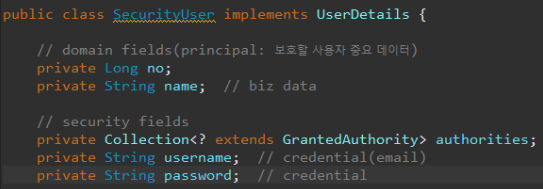
여기서 회원의 정보 principal의 name을 가져오기 위해서는 아래의 코드를 적으면 된다.
<sec:authentication property="principal.name" />
[5] jsp에 권한 제한 하기
- 사용
페이지에서 F12(개발자모드) 혹은 소스코드보기를 통해 코드를 감추고 싶을 때 taglib를 이용해 권한을 제한할 수 있다.
[1] 일단 태그라이브러리를 추가한다.
<%@ taglib prefix="sec" uri="http://www.springframework.org/security/tags" %>
[2] 가리고 싶은 코드를 <sec:authorize access="hasRole('ROLE_ADMIN')" >로 감싸준다.
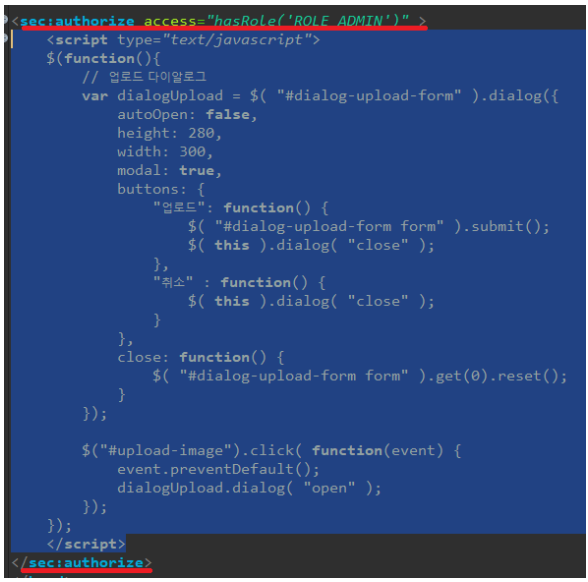
소스코드 보기로 확인

[3] html 태그에도 적용이 가능하다.
- 관리자가 아닐 경우 업로드 방지를 위해 업로드 버튼을 숨긴다.

-
해당 버튼의 url경로를 막는다.
SecurityConfig.java에서 설정
@Override protected void configure(HttpSecurity http) throws Exception { ... .antMatchers("/gallery/upload", "/gallery/delete/**").hasAuthority("ROLE_ADMIN") }
권한에 따라 다르게 보이는 화면
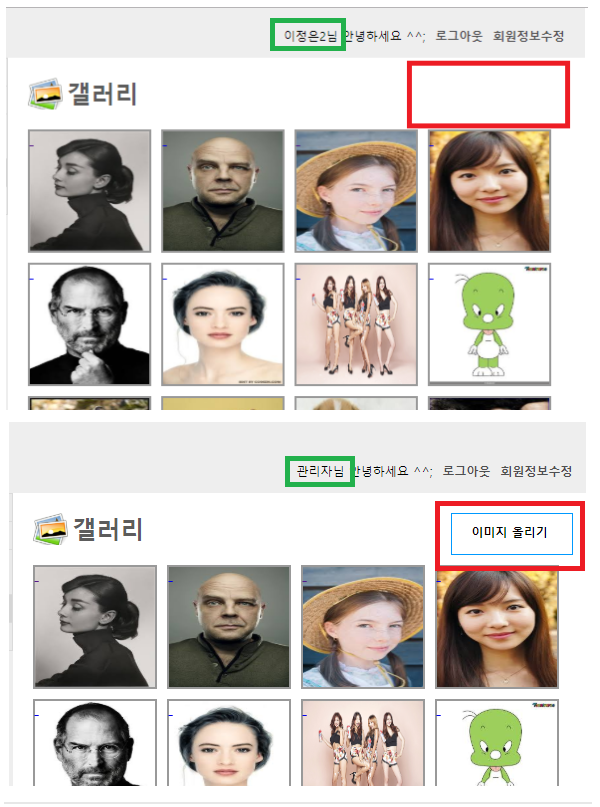

 콩정의 개발 정리 블로그
콩정의 개발 정리 블로그
